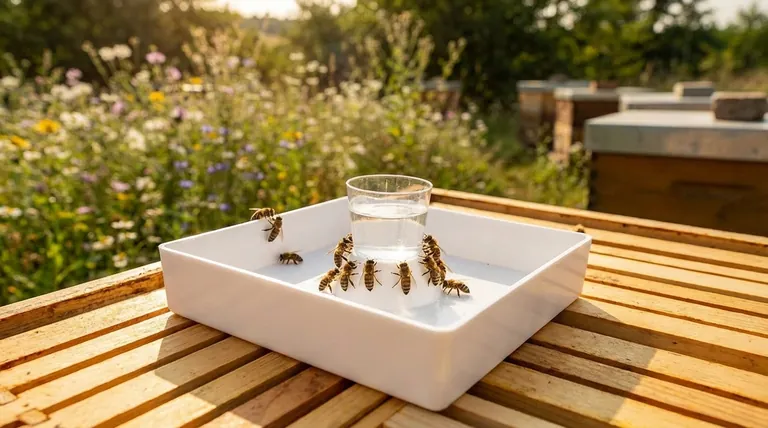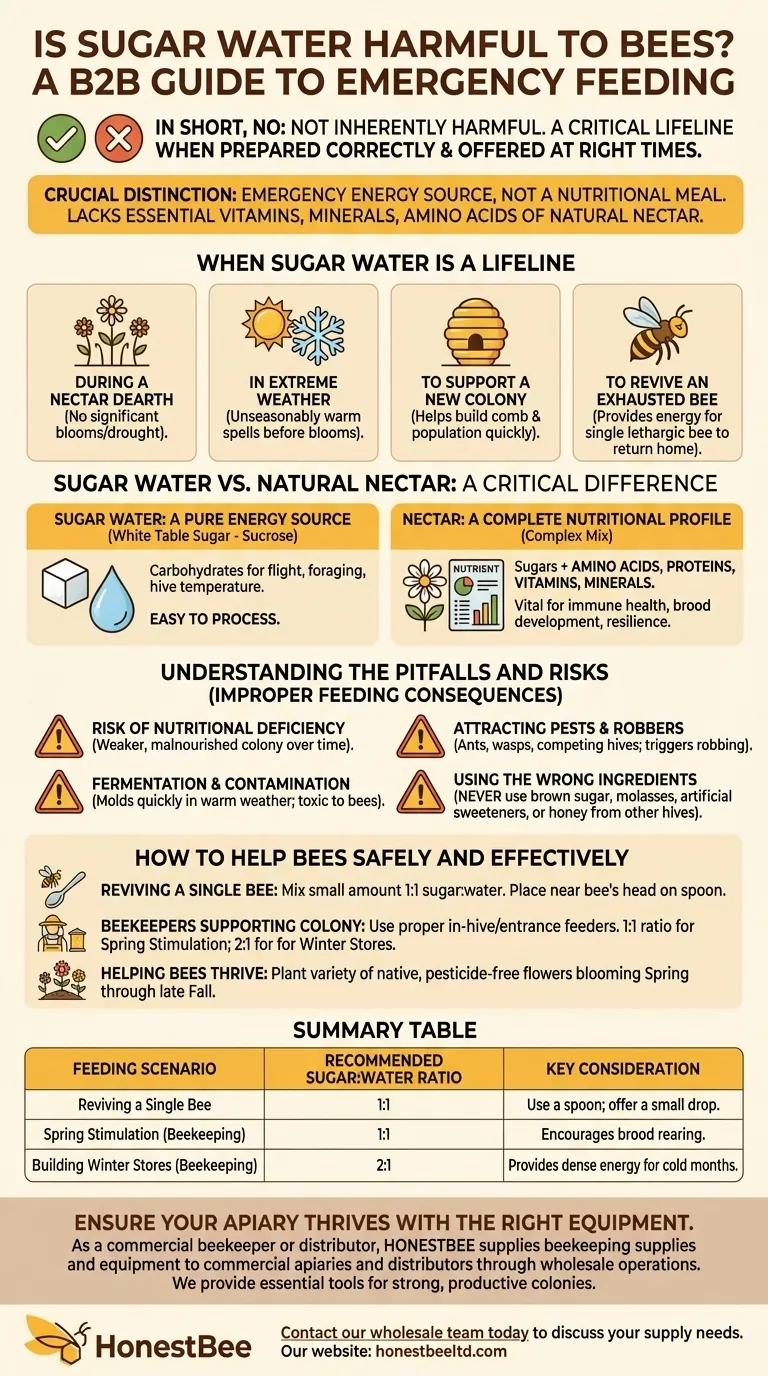In short, no, sugar water is not inherently harmful to bees. When prepared correctly and offered at the right times, it can be a critical lifeline, providing them with the energy needed for survival during periods when natural food sources are scarce. It serves as a temporary substitute when flowers aren't available due to drought, unseasonable weather, or other environmental stresses.
The crucial distinction to understand is that sugar water is an emergency energy source, not a nutritional meal. While it can save bees from starvation, it lacks the essential vitamins, minerals, and amino acids found in natural nectar that are vital for long-term colony health.

When Sugar Water is a Lifeline for Bees
Feeding bees is an act of intervention. It should be reserved for specific situations where the benefits clearly outweigh the potential drawbacks.
During a Nectar Dearth
A nectar dearth is a period when there are no significant nectar-producing flowers in bloom. This can happen in the middle of summer or during a drought, leaving bees without their primary food source.
In Extreme Weather
Unseasonably warm spells in late winter or early spring can cause bees to become active before flowers have bloomed. A supplemental sugar source provides the energy they need to survive until nature catches up.
To Support a New Colony
Beekeepers often feed new colonies to help them build comb and grow their population quickly. This initial support helps them become established and self-sufficient before the first major nectar flow.
To Revive an Exhausted Bee
It is common to find a single, lethargic bee on the ground, unable to fly. This individual is often simply exhausted and out of energy, and a small drop of sugar water can provide the fuel it needs to return to its hive.
Sugar Water vs. Natural Nectar: A Critical Difference
Understanding why sugar water is a temporary fix requires comparing it to a bee's natural diet.
Sugar Water: A Pure Energy Source
A simple solution of white table sugar (sucrose) and water provides bees with carbohydrates. They can easily process this into the energy required for flight, foraging, and temperature regulation within the hive.
Nectar: A Complete Nutritional Profile
Natural nectar is far more complex. In addition to sugars, it contains a vital mix of amino acids, proteins, vitamins, and minerals. These components are essential for immune health, brood development, and the overall resilience of the colony.
Understanding the Pitfalls and Risks
Improper feeding can do more harm than good. It's essential to be aware of the potential consequences.
The Risk of Nutritional Deficiency
Relying on sugar water for extended periods can lead to a weaker, malnourished colony. It is a crutch, not a long-term diet plan.
Attracting Pests and Robbers
An open source of sugar water can attract ants, wasps, and bees from competing hives. This can trigger robbing, where stronger colonies attack and steal resources from weaker ones, often destroying the weaker hive in the process.
Fermentation and Contamination
Sugar water can ferment and grow mold quickly, especially in warm weather. Consuming this spoiled syrup can be toxic to bees. Feeders must be kept scrupulously clean.
Using the Wrong Ingredients
Never use brown sugar, molasses, or artificial sweeteners. These contain compounds that are indigestible or toxic to bees. Likewise, do not offer honey from another hive, as it can transmit devastating diseases like American Foulbrood. Only plain, granulated white sugar should be used.
How to Help Bees Safely and Effectively
Your approach should match your goal. The method for saving one bee is very different from supporting an entire hive.
- If you are reviving a single, tired bee: Mix a small amount of 1:1 sugar and water on a spoon. Place the spoon near the bee's head so it can drink without falling in.
- If you are a beekeeper supporting a colony: Use a proper in-hive or entrance feeder to prevent robbing and keep the syrup clean. Use a 1:1 sugar-to-water ratio for spring stimulation and a 2:1 ratio for winter stores.
- If your primary goal is to help bees thrive in your area: The single best action is to plant a variety of native, pesticide-free flowers that bloom from early spring through late fall.
By understanding when and how to offer support, you can provide a crucial lifeline instead of an unintended hindrance.
Summary Table:
| Feeding Scenario | Recommended Sugar:Water Ratio | Key Consideration |
|---|---|---|
| Reviving a Single Bee | 1:1 | Use a spoon; offer a small drop. |
| Spring Stimulation (Beekeeping) | 1:1 | Encourages brood rearing. |
| Building Winter Stores (Beekeeping) | 2:1 | Provides dense energy for cold months. |
Ensure your apiary thrives with the right equipment.
As a commercial beekeeper or distributor, providing proper nutrition is just one part of successful hive management. You need reliable, high-quality supplies to support your operations year-round.
HONESTBEE supplies beekeeping supplies and equipment to commercial apiaries and beekeeping equipment distributors through our wholesale-focused operations. We provide the essential tools—from durable feeders to protective gear—that help you maintain strong, productive colonies.
Contact our wholesale team today to discuss your supply needs and discover how we can support the health of your business and your bees.
Visual Guide

Related Products
- HONESTBEE Professional Hive Top Bee Feeder Feeding Solution
- HONESTBEE Entrance Bee Feeder Professional Hive Nutrition Solution for Beekeeping
- HONESTBEE Round Hive Top Bee Feeder for Syrup
- HONESTBEE Advanced Ergonomic Stainless Steel Hive Tool for Beekeeping
- Professional Hive Top Bee Feeder for Beekeeping
People Also Ask
- What should be done with feeders and equipment after feeding bees? Essential Steps for Apiary Health
- Do I need an inner cover with a hive top feeder? Optimize Your Hive Setup for Healthy Bees
- What is a top feeder for bees? Maximize Colony Health with Efficient Feeding
- How do I keep bees from drowning in my top feeder? Ensure Safe Feeding for Your Hive
- What features make top feeders a reliable choice for beekeepers? A Guide to Safe, Efficient Hive Nutrition



















